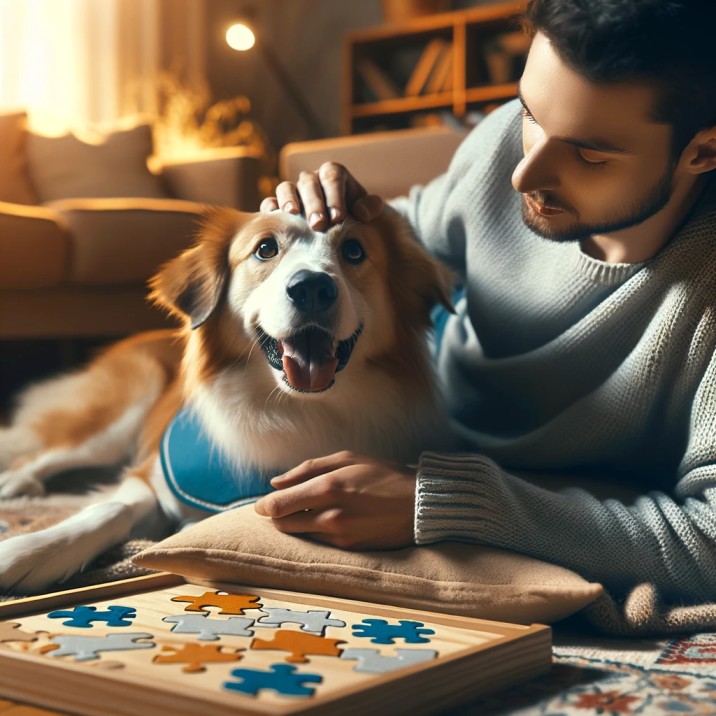The concept of autism in dogs, while not officially recognized or diagnosed in veterinary medicine as it is in humans, often relates to certain behavioral traits and patterns that can be described as autistic-like symptoms. It’s important to note that these observations are based on behavioral similarities and not on a medical diagnosis. The signs that might suggest autistic-like behaviors in dogs include:
- Repetitive Behaviors: Dogs may exhibit unusual repetitive actions such as obsessive tail chasing, walking in circles, or fixation on a single object or activity.
- Social Interaction Difficulties: Dogs showing signs of autism-like symptoms may display a lack of interest in playing with other dogs or humans. They might avoid eye contact, seem indifferent to human presence, or not respond to their names or familiar commands.
- Sensitivity to Sensory Stimuli: Some dogs might react unusually to sensory inputs like sounds, sights, or textures. This could manifest as an overreaction to loud noises or a distinct aversion to certain textures.
- Physical Coordination Issues: Unusual gait, trouble with balance, or awkward movements might be observed. These signs could also indicate other neurological or physical conditions.
- Routine-Dependent: Dogs with these symptoms often thrive on routine and can become distressed or anxious with changes in their environment or schedule.
- Muted or Intense Emotional Responses: Emotional responses in these dogs can be less expressive, or, conversely, they might show exaggerated fear or distress in response to minor changes or stimuli.
- Anxiety: Dogs with autistic-like symptoms may exhibit signs of anxiety more frequently or intensely than other dogs.
It is important to approach these behaviors with an understanding that they may not necessarily indicate autism as understood in humans. Many of these symptoms can also be signs of other behavioral or neurological issues. Diagnosis and management should always involve consultation with a veterinarian or a qualified animal behaviorist to ensure the dog receives appropriate care and support.
How to Interact with a dog that exhibits autistic-like behavior?

Interacting with a dog that exhibits autistic-like behaviors requires patience, understanding, and a tailored approach to accommodate their unique needs. While autism is not officially diagnosed in dogs as it is in humans, dogs can display behaviors that are similar to autism spectrum disorder. Here’s how to best support and interact with such dogs:
- Create a Routine: Dogs with autistic-like tendencies often thrive on predictability. Establish and maintain a consistent daily routine for feeding, walks, playtime, and rest. This helps reduce their anxiety and makes them feel more secure.
- Ensure a Calm Environment: Minimize stress by providing a calm and safe environment. Avoid loud noises and chaotic situations that could overwhelm the dog. If changes to the environment are necessary, introduce them gradually.
- Be Patient During Training: Training might require more patience. Use positive reinforcement techniques and be consistent with commands. Understand that progress may be slow and celebrate small achievements.
- Avoid Overstimulation: Be mindful of the dog’s sensory sensitivities. Overstimulation can be distressing, so it’s important to recognize and avoid situations that might trigger anxiety or discomfort.
- Use Non-Verbal Communication: Dogs with autistic-like behaviors may respond better to non-verbal cues than verbal commands. Use gestures and body language to communicate your intentions.
- Familiarize Yourself with Their Likes and Dislikes: Pay attention to what comforts and upsets your dog. Some might dislike being touched in certain ways or being in crowded places. Respecting their preferences is key to building trust.
- Provide Safe Spaces: Have a designated safe spot in your home where the dog can retreat to when they feel overwhelmed or anxious. This could be a crate, a quiet room, or a special bed.
- Gentle Socialization: Carefully expose them to new experiences, people, and other animals. Keep socialization sessions short and positive. Forced social interactions can be counterproductive.
- Monitor Health Closely: Dogs with autistic-like behaviors may not always communicate pain or discomfort clearly. Regular veterinary check-ups are important to ensure they remain in good health.
- Stay Informed and Flexible: Each dog is unique, and what works for one may not work for another. Stay open to learning and adapting your approach as you understand more about your dog’s specific needs and behaviors.
- Seek Professional Help: Don’t hesitate to seek advice from veterinarians or animal behaviorists, especially if you face challenges in managing your dog’s behavior.
- Provide Structured Play: Engage in structured play activities that your dog enjoys and can predict. Predictable, structured play can be comforting to dogs with autistic-like behaviors.
Remember, while these guidelines can help in managing a dog with autistic-like behaviors, each dog’s needs and preferences can vary greatly. Building a strong, understanding relationship based on mutual trust and respect is key to providing the best care for your dog.

